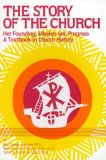The Story of the Church: Her Founding, Mission and Progress is one of the most comprehensive, yet understandable, Catholic Church history texts I've seen for junior and senior high level. Although originally written in 1935 and updated in 1946, it does an excellent job covering up to through the end of WWII. Many biographical sketches help put a "human face" on Church history. The writing style is interesting, and this is at least partly attributable to the authors' efforts to relate events to one another, showing cause and effect. They frequently discuss cultural and historical factors that influenced events; for example we read through a few pages of fascinating background before the recounting of the story of Pope Innocent III placing all of England "...under an interdict because King John insisted on appointing someone of his own choice Archbishop of Canterbury...." (pp. 233-34).
Questions that can be used for either discussion or written assignments appear about every six pages. Each of the fourteen major units includes a "self-test" at the end. Self-tests encourage students to review primary objectives of the unit, then offer a number of possible topics for 2-minute speeches, discussion questions, a debate topic, writing assignments (including at least one for a research paper), and additional books to read. (The self-tests are vivid reminders of how much we've lowered our expectations from students in the last half-century, and they should also serve as prompts for homeschooling parents to think about providing opportunities for their children to practice public speaking.)
There is no answer key available from TAN Books, so parents should try to read the text themselves to be prepared to guide discussion and evaluate student responses. This is such an engaging book, that parents with adequate time should find this a rewarding task. (Apparently, Seton offers a partial answer key for this book. Check with them for availability.)
The book is well over 500 pages in length, and it includes an index plus a list of popes and a selective chronology at the end. Given its "pocket-book" format, the 500 pages isn't as overwhelming as it sounds. The book carries both the Nihil Obstat and Imprimatur.









